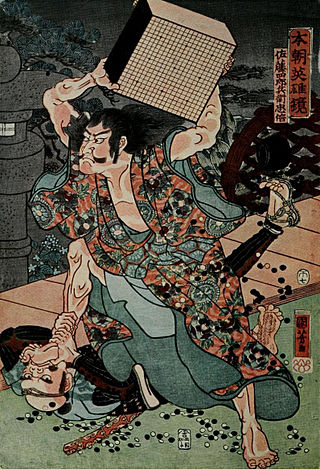Related Research Articles

Shusaku was a Japanese professional Go player during the 19th century. He is known for his undefeated streak of 19 games during the annual castle games; his thirty-game match with Ota Yuzo; the eponymous Shusaku opening; and his posthumous veneration as a "Go sage". Next to his teacher, Hon'inbō Shūwa, he is considered to have been the strongest player from 1847/8 to his death in 1862. He was nicknamed Invincible Shusaku because of his castle games performance.

Hon'inbō Sansa was the assumed name of Kanō Yosaburō , one of the strongest Japanese Go players of the Edo period (1603–1867), and founder of the house of Hon'inbō, first among the four great schools of Go in Japan. He was a Buddhist priest of the Nichiren sect, and his original dharma name was Nikkai (日海).

The game of Go originated in China in ancient times. It was considered one of the four essential arts of a cultured Chinese scholar in antiquity and is described as a worthy pastime for a gentleman in the Analects of Confucius. It reached Korea by the 5th century, in the 7th century it had reached Japan. The game was described by Thomas Hyde in 1694, but it did not become popular in the West until the late 19th century.
Meijin (名人) means "Brilliant Man". It is the name of the second most prestigious Japanese Go Tournament. It also refers to a traditional Japanese title given to the strongest player of the day during the Edo period.
Hon'inbō Shūho, also known as Murase Shūho, was the first Japanese professional go player to have a reputation in the Western world.
Hon'inbō Shūsai is the professional name of Hoju Tamura, also known as Yasuhisa Tamura, who was a Japanese professional Go player.

In the history of Go in Japan, the four Go houses were four major schools of Go instituted, supported, and controlled by the state, at the beginning of the Tokugawa shogunate. At roughly the same time shogi was organised into three houses. Here "house" implies an institution run on the recognised lines of the iemoto system common in all Japanese traditional arts. In particular, the house head had, in three of the four cases, a name handed down: Inoue Inseki, Yasui Senkaku, Hayashi Monnyu. References to these names, therefore, mean to the contemporary head of the house.

Hon'inbō Dōsaku was a professional Go player.
Hon'inbō Shūei was a Japanese professional Go player.

Iemoto is a Japanese term used to refer to the founder or current Grand Master of a certain school of traditional Japanese art. It is used synonymously with the term sōke (宗家) when it refers to the family or house that the iemoto is head of and represents.
Ōta Yūzō was a professional Go player.
Hon'inbō Dōchi was a professional Go player.
Hon'inbō San'etsu was a professional Go player, and second head of the Hon'inbō house.
Hon'inbō Dōetsu was a Japanese professional go player, who became the third head of the Honinbo house. His surname was Niwa, and he used a Buddhist name Nissho.
Hon'inbō Chihaku was a Japanese professional go player, and sixth head of the Hon'inbō house.
Nakamura Dōseki was a Japanese professional Go player. Tradition counts him as the founder of the Inoue house. This was in fact a retrospective inclusion, essentially a fabrication of the early nineteenth century by Inoue Gennan Inseki. It accounts for the name Inoue Nakamura Dōseki sometimes given.
Hon'inbō Shūwa was a Japanese professional Go player, and also the fourteenth head of the Hon'inbō house from 1847 to 1873.
Honinbo Retsugen was a Japanese professional go player, and tenth head of the Hon'inbō house.
Hon'inbō Shūetsu was a Japanese professional Go player, and fifteenth head of the Hon'inbō house.

Igo Hatsuyōron is a collection of 183 go problems, compiled in 1713 by the Japanese go master Inoue Dōsetsu Inseki.